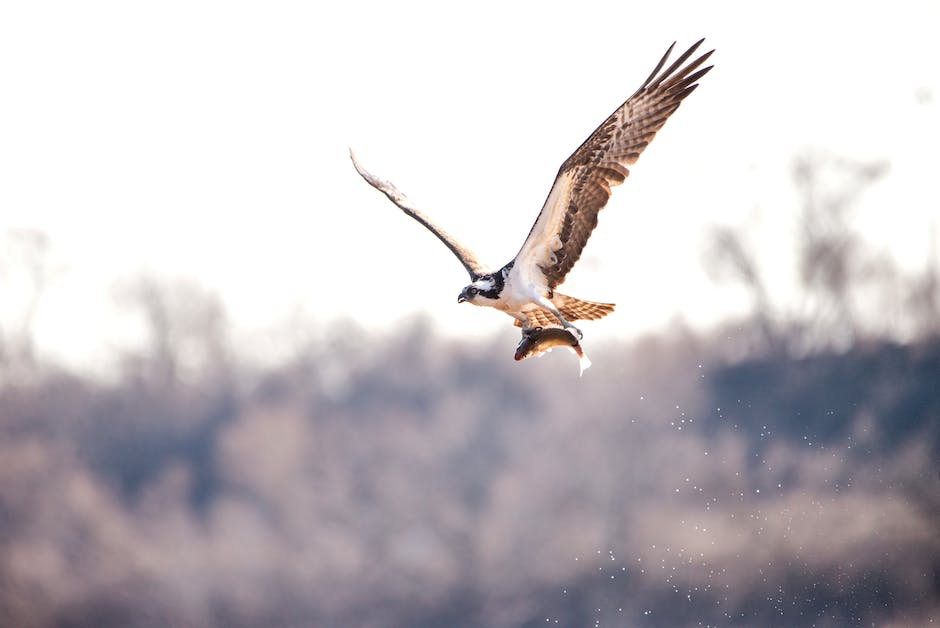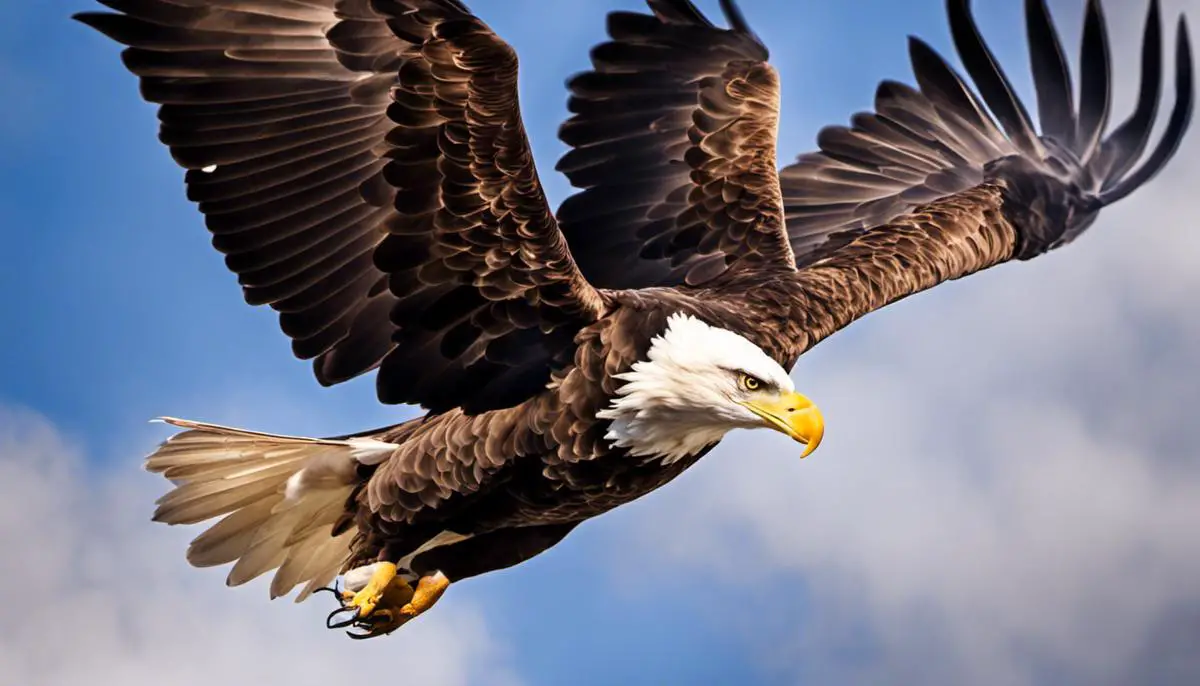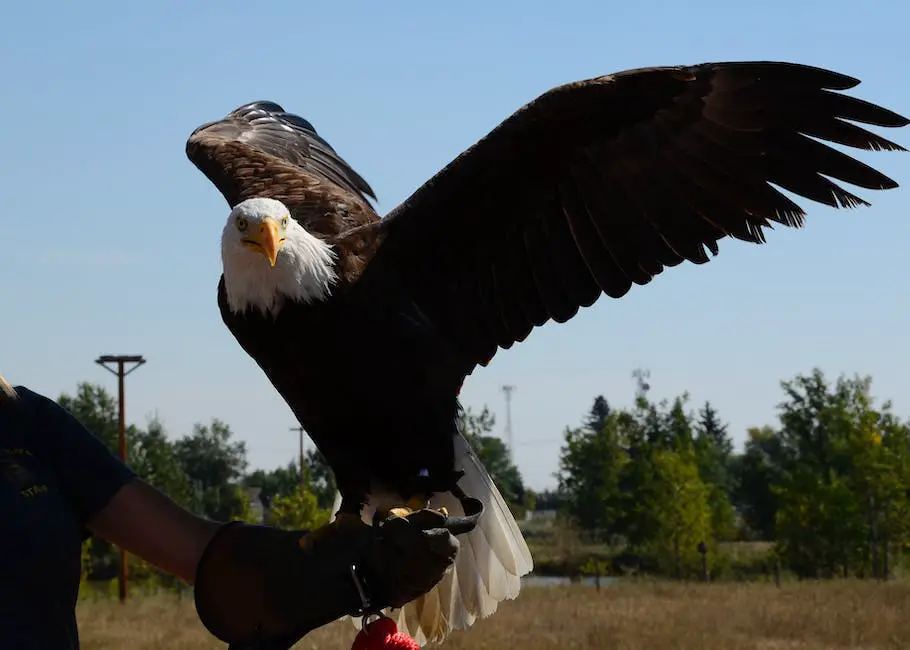Bald Eagles’ Diet: In-depth Exploration
The majestic bald eagle, a beacon of strength and symbol of freedom, is an intriguing figure in avian ecology, partly due to its adaptive dietary habits. Manifesting resplendent physical attributes, the bald eagle’s remarkable adaptability has enabled it to thrive in diverse habitats across North America.
While its distinct behaviours, most notably its hunting prowess, have captivated keen observers, its diet, which encompasses a variety of prey reflects the eagle’s ability to adjust to changing surroundings. Thus, understanding the bald eagle, its diet, its survival strategies, and ultimately, its inextricable influence on the ecological stability of its habitat, paves the way toward offering crucial insights into this emblematic bird species.

Characteristics of Bald Eagles
Physical Attributes and Habitat of Bald Eagles
Bald Eagles, known scientifically as Haliaeetus leucocephalus, are magnificent birds native to North America. With a formidable wingspan of 5.9 to 7.5 feet (1.8 to 2.2 metres) and a weight that ranges between 6.6 to 14 pounds (3 to 6.3 kilograms), these birds are well-equipped for their predatory lifestyle. Their physical characteristics, including piercing eyes, sharp talons, and powerful beaks, are crucial to their hunting prowess. They primarily inhabit areas close to bodies of water such as rivers, lakes, marshes, and coasts, as their diet largely revolves around fish.
Hunting Skills and Feeding Habits of Bald Eagles
Bald Eagles are renowned for their exceptional hunting skills. Possessing extremely sharp eyesight, these raptors can spot potential prey from a considerable distance. Even in flight, they can swoop down with pinpoint accuracy to capture their food. They have a propensity to feed near water bodies, often perching in high places to identify fish close to the water surface before making a swift dive to snatch them. These birds are not above scavenging or stealing food from other birds and even mammals if the opportunity arises. They consume food in small bites, using their sharp beak to tear apart their prey, which is then processed by their robust digestive system which can handle a range of food items, including bones.
Diet of Bald Eagles
While Bald Eagles are capable carnivores, they are not particularly picky eaters and their diet largely depends on the availability of prey in their environment. Their diet primarily consists of fish such as salmon, trout, and shad, however, they also feast on various small to medium-sized mammals like rabbits, squirrels, and even baby deer. They equally consume a variety of birds, including ducks, geese and gulls. Due to their opportunistic nature, these raptors will also feed on carrion and leftover carcasses, especially during colder periods when live prey might be scarce.
Seasonal Variation in Diets of Bald Eagles
Notably, the diet of Bald Eagles also varies seasonally. During the nesting season when they are raising their young, a high-protein diet made up of fish and fresh kills is critical. Conversely, during the winter months, when live prey can be hard to come by, Bald Eagles switch to a diet of carrion. It is during these times that they might be seen foraging in garbage dumps or feasting on carrion on the roadside.
Ultimately, due to its diverse dietary preferences and undeniably superior hunting prowess, the Bald Eagle thrives across a variety of environments stretching across North America.

Dietary Habits of Bald Eagles
Main Diet of Bald Eagles
The bald eagle, Haliaeetus leucocephalus, is primarily a piscivore, with fish constituting an estimated 56-90% of its alimentation. These magnificent birds of prey are opportunistic in their feeding habits, implying they do not limit their intake to particular species of fish. Rather, they consume a wide variety, including the likes of shad, salmon, herring, and catfish, depending on what’s readily available.
Hunting Tactics
Bald eagles are skilled hunters demonstrating incredible power and precision. They typically hunt by swooping down at high speeds to grab fish swimming near the water’s surface with their sharp talons. Sometimes, they may hunt from a stationary position, waiting patiently for hours on a high perch and scanning the water for prey. Bald eagles can catch fish weighing up to 4 lbs, displaying their dexterity and strength.
Seasonal Variations in Diet
While fish constitute the majority of a bald eagle’s diet, their eating habits may vary with the seasonal availability of different types of prey. During harsh winters, when bodies of water freeze over, they may switch to feasting on waterfowl such as ducks and geese. They are also known to feed on small mammals like rabbits and squirrels when fish and birds are scarce.
Scavenging Behaviour
Bald eagles also exhibit scavenging behaviour. Their robust digestive system allows them to consume carrion, which provides them a vital food source, particularly during colder months when hunting may prove problematic due to ice cover on water bodies. They often steal kills from other predators, a behaviour termed as kleptoparasitism, where they harass smaller birds of prey forcing them to relinquish their catch.
Factors Influencing the Dietary Preferences of Bald Eagles
The diet of a bald eagle, while diverse, hinges greatly on factors such as geographical location and the accessibility of prey. For instance, those residing near the coastlines or large water bodies have an abundant supply of fish, and therefore, it forms a major part of their diet. On the other hand, eagles inhabiting arid or semi-arid regions tend to prey on land mammals or scavenge on carcasses.
Their ability to adapt to various ecosystems and switch between different food sources is a vital element of their survival. It enables them to prosper in various habitats across North America. The availability of food also affects the type and size of their prey. For instance, when smaller prey, such as fish and rabbits, are in short supply, they turn to larger prey like deer fawns. Their proficiency in altering their food choices based on geographical and seasonal changes is critical to their role as apex predators.

Ecological Impact of Bald Eagles’ Eating Habits
Comprehending the Bald Eagles’ Feeding Habits
Bald eagles’ primary sustenance consists of fish, indicative of their opportunistic feeding behaviour as they do not distinguish between various kinds of fish. They consume both freshwater and marine species, with a particular preference for salmon, catfish, shad, and carp. However, it’s incorrect to label bald eagles as solely piscivorous (fish-eating). Their dietary repertoire extends to an array of small animals such as hares, rabbits, turtles, and occasionally, other birds.
Ecological Impact of Bald Eagles’ Eating Habits
Bald eagles’ feeding habits have a profound ecological impact on their habitats. Being apex predators, they play a crucial role in controlling the population of species at lower trophic levels, particularly aquatic organisms. Their predation ensures balance in prey population sizes, aiding in maintaining healthy and sustainable ecosystems.
Moreover, they also perform vital ecological functions as scavengers. Bald eagles positively contribute towards nutrient recycling in ecosystems by cleaning up carcasses and preventing the spread of diseases. The diet of these eagles also includes carrion (dead animals). As scavengers, they play an essential role in their ecosystem, disposing of the remains of deceased animals which could otherwise present risks of disease or attracting other potentially dangerous scavengers.
Human Activities and Eagles’ Food Source
Human activities can significantly impact bald eagles’ food sources. Overfishing or pollutant infiltration in water bodies negatively affects fish populations, which are the bald eagle’s primary food source. Pesticides like DDT used in agriculture which end up in water bodies can get into the fish the bald eagles eat, leading to conditions like eggshell thinning, which can affect their reproduction.
Moreover, artificial feeding by humans can disrupt the dietary habits of bald eagles. Handouts, garbage, and road kill comprise such artificial feeding sources and while they might seem beneficial in a short time frame, they can reduce the eagles’ natural foraging behaviour and negatively impact their health in the long run.
Conservation Perspective
Despite the introduction of several conservation measures aimed at protecting the bald eagle, this predator’s survival still heavily relies on the availability and quality of their food source. Hence, catering to the bald eagles’ diet needs indirectly means preserving the balance and health of the overall ecosystem. To ensure the survival and prosperity of these magnificent birds, it is essential for humans to alter their activities that directly or indirectly impact the eagles’ diets. This may include modifying fishing quotas, reducing pollution, and refraining from providing artificial food sources.
While the bald eagle captivates with its majesty and infuses vitality into human iconography, its role in nature is also profoundly significant. The predatory and scavenging tendencies of bald eagles contribute to the delicate ecological balance of their habitats. Their dietary flexibility not only proves instrumental in their survival but also mirrors the dynamism of the natural world. However, the human imprint on their habitats and food sources trigger profound ramifications for their survival and reproduction, making it pivotal to recognize and protect their role in maintaining ecological harmony. As such, the study of the diet and dining habits of bald eagles animates broader conversations about their ecological impact and humanity’s responsibility towards these awe-inspiring birds.
